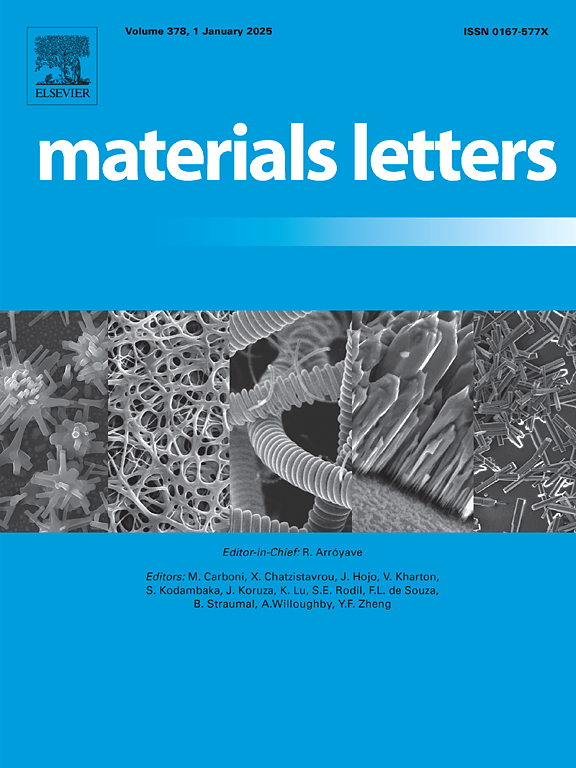用Ge取代调整CuCrO2的磁性基态
IF 2.7
4区 材料科学
Q3 MATERIALS SCIENCE, MULTIDISCIPLINARY
引用次数: 0
摘要
采用常规固相反应合成了多晶CuCr0.95Ge0.05O2。x射线衍射证实其为菱形拖岩结构(R-3m)。改进后的晶格参数与标准值几乎相同,表明Ge掺入畸变较小。扫描电镜(SEM)显示晶粒为六边形,平均尺寸为3.6±0.9 μm。磁性表征为低温弱铁磁性,室温顺磁性。零场冷却磁化率测得居里温度(TC)为139.3±0.4 K,居里常数(C = 1.425±0.002)、居里-魏斯温度(Θ =−138.8±0.4 K)和有效磁矩(μeff = 3.37 μB)与Cr3+亚晶格一致。TC附近附加的场相关磁化(M-H)环在110 ~ 135 K范围内呈现迟滞,矫顽力随温度近似线性下降。外推得到TC = 139.8±3.6 K,与敏感性结果一致。这些发现表明,Ge取代保留了CuCrO2的沉积结构,同时诱导了弱铁磁有序,为调节磁基态提供了一条途径。本文章由计算机程序翻译,如有差异,请以英文原文为准。
Tuning the magnetic ground state of CuCrO2 by Ge substitution
Polycrystalline CuCr0.95Ge0.05O2 was synthesized by a conventional solid-state reaction. X-ray diffraction confirmed the rhombohedral delafossite structure (R–3m). The refined lattice parameters are nearly identical to standard values, indicating Ge incorporation with minor distortion. Scanning electron microscopy (SEM) revealed hexagonal-like grains averaging of 3.6 ± 0.9 μm. Magnetic characterization showed weak ferromagnetism at low temperatures and paramagnetism at room temperature. Zero-field-cooled susceptibility identified a Curie temperature (TC) of 139.3 ± 0.4 K, and Curie–Weiss fitting yielded a Curie constant (C = 1.425 ± 0.002), a Curie–Weiss temperature (Θ = −138.8 ± 0.4 K), and an effective magnetic moment (μeff = 3.37 μB), consistent with the Cr3+ sublattice. Additional field-dependent magnetization (M–H) loops near TC revealed hysteresis in the 110–135 K range, with coercivity decreasing nearly linearly with temperature. Extrapolation yielded TC = 139.8 ± 3.6 K, consistent with susceptibility results. These findings demonstrate that Ge substitution preserves the delafossite structure of CuCrO2 while inducing weak ferromagnetic ordering, offering a route to tune the magnetic ground state.
求助全文
通过发布文献求助,成功后即可免费获取论文全文。
去求助
来源期刊

Materials Letters
工程技术-材料科学:综合
CiteScore
5.60
自引率
3.30%
发文量
1948
审稿时长
50 days
期刊介绍:
Materials Letters has an open access mirror journal Materials Letters: X, sharing the same aims and scope, editorial team, submission system and rigorous peer review.
Materials Letters is dedicated to publishing novel, cutting edge reports of broad interest to the materials community. The journal provides a forum for materials scientists and engineers, physicists, and chemists to rapidly communicate on the most important topics in the field of materials.
Contributions include, but are not limited to, a variety of topics such as:
• Materials - Metals and alloys, amorphous solids, ceramics, composites, polymers, semiconductors
• Applications - Structural, opto-electronic, magnetic, medical, MEMS, sensors, smart
• Characterization - Analytical, microscopy, scanning probes, nanoscopic, optical, electrical, magnetic, acoustic, spectroscopic, diffraction
• Novel Materials - Micro and nanostructures (nanowires, nanotubes, nanoparticles), nanocomposites, thin films, superlattices, quantum dots.
• Processing - Crystal growth, thin film processing, sol-gel processing, mechanical processing, assembly, nanocrystalline processing.
• Properties - Mechanical, magnetic, optical, electrical, ferroelectric, thermal, interfacial, transport, thermodynamic
• Synthesis - Quenching, solid state, solidification, solution synthesis, vapor deposition, high pressure, explosive
 求助内容:
求助内容: 应助结果提醒方式:
应助结果提醒方式:


